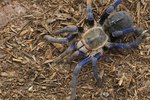
The Mojave Desert encompasses 25,000 square miles, covering portions of California, Nevada, Arizona and Utah, and includes Death Valley. Despite the hot, arid climate and sparse vegetation, it is teeming with life. Throughout the desert southwest there are 55 families of spiders, though only a few species inhabit the Mojave desert.
Camels in the American Desert
Also known as sunspiders or whipscorpions, camel spiders are named for the regions in the Middle East where they were first discovered. With a preference for shade, camel spiders will move with a shadow to remain in it. This often gives humans the disconcerting impression the spider is chasing them. Luckily, human flesh is not on the camel spider's menu. Instead, he prefers to clamp his strong jaws around flies, moths, cockroaches, beetles, crickets and other spiders including scorpions. Hunting by stealth and speed, a camel spider can reach up to 10 miles per hour, enabling him to easily run down his prey.
A Wolf in an Arachnid's Clothing
The large, hairy wolf spider is nearly the size of a tarantula, and many times is mistaken for one. Much like the camel spider, this swift hunter runs down his prey of grasshoppers, crickets, roaches, beetles and other spiders. Unlike the camel spider, the wolf spider possesses venom. His fang-like mouth parts are capable of tearing flesh when he bites, inflicting a rather painful wound prone to swelling and even blackening of the skin. In desert environments, the wolf spider will stake out a home territory that offers protection from the daytime heat. His substantial body invites him to be preyed upon by coyotes, owls and large, predatory insects. If pinned down, he may sacrifice a leg to enable his escape.
Reclusive Spiders
If you see a recluse, or violin spider, in the Mojave Desert, chances are it's a desert recluse or an Arizona recluse. The body and legs of the recluse are uniformly colored, without spots, rings or stripes. Nocturnal hunters, the desert recluse's venom is similar in potency to that of the brown recluse and has the potential to cause necrotic flesh at the bite site. As dawn approaches each day, the recluse will seek out shelter in cracks and crevices, under rocks, wood, tires or debris, or inside your clothing or shoes. Since recluse spiders can inhabit human dwellings, they are considered house spiders as well as desert spiders.
The Yeti of the Spider World
Tarantulas are the arachnid equivalent of Big Foot -- big and hairy, and largely misunderstood. Reaching 2 to 3 inches in length, the tarantula's body is covered with thousands of fine hairs he can shed into the eyes of his predators. Solitary, burrowing spiders, the tarantula is an ambush hunter that will chase his prey rather than ensnare it. Timid and gentle in nature, a tarantula will not bite a human unless he is harassed or provoked.
Desert Crabs
Crab spiders can be found in some areas of the Mojave Desert, although they typically can't tolerate the driest, hottest areas. These spiders have flat, wide bodies with shorter front legs and wider hind legs. They scurry sideways and backwards, much like their namesake, the crab. Worldwide there are about 2,000 species of crab spider, with 125 of those living in the United States. In the Mojave Desert, you're most likely to find the inconspicuous crab spider.
Scary Scorpions
At least 10 different species of scorpions inhabit the Mojave Desert. The North American hairy scorpion is the largest, growing 4 to 7 inches in length. Tan to olive green, this nocturnal hunter preys upon insects, lizards, small mammals and other scorpions. Females cannibalize males after breeding. The Arizona bark scorpion is one of the world's most dangerous scorpions, with venom that could potentially kill a human. He is aggressive, and quick to sting if provoked. The bite of an Arizona bark scorpion may cause foaming at the mouth, swelling at the bite site and labored breathing.
References
- Center for Biological Diversity: Mojave Desert
- Mojave Desert Land Trust: Camel Spiders
- DesertUSA: The Wolf Spider
- UC IPM Online: Brown Recluse and Other Recluse Spiders
- National Park Service: Tarantula
- Animal Diversity Web: Hadrurus Arizonensis
- Arizona-Sonora Desert Museum: Animal Fact Sheet -- Bark Scorpion
- Encyclopedia Brittanica: Crab Spiders
Resources
Photo Credits
-
Duncan Smith/Photodisc/Getty Images




